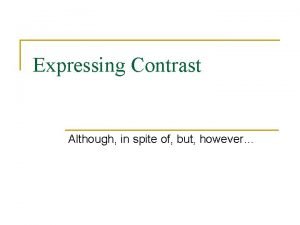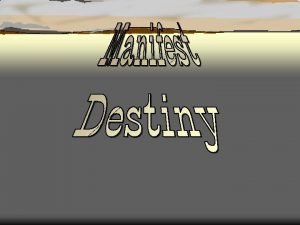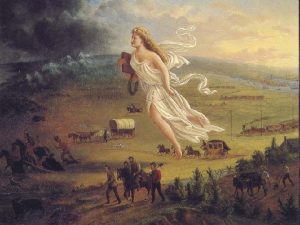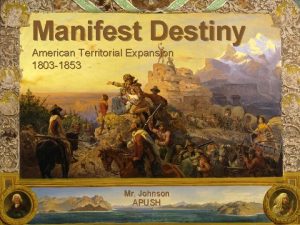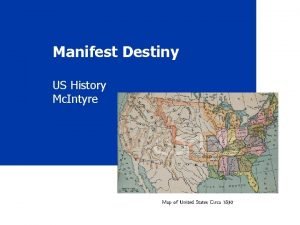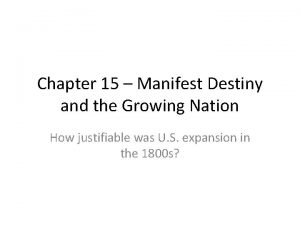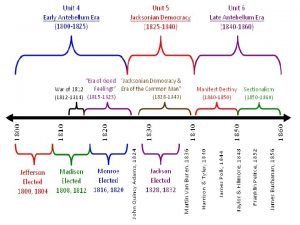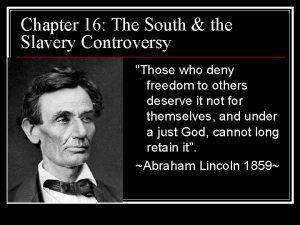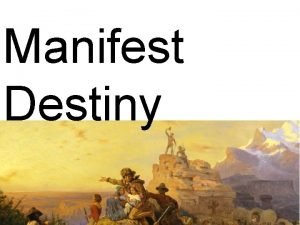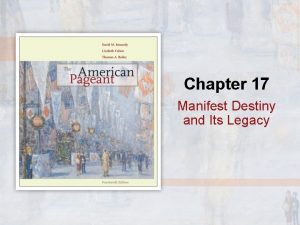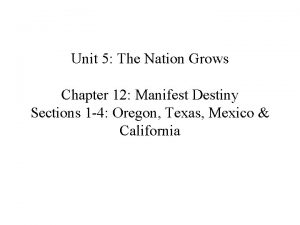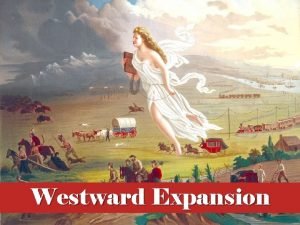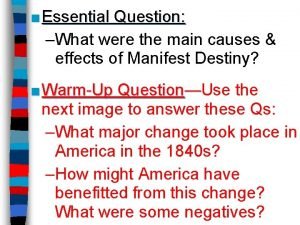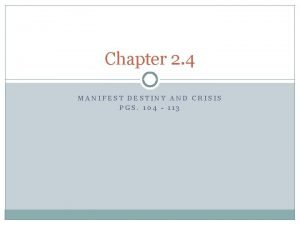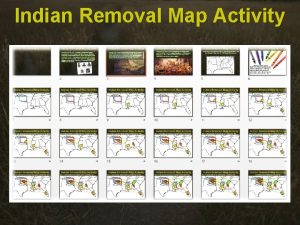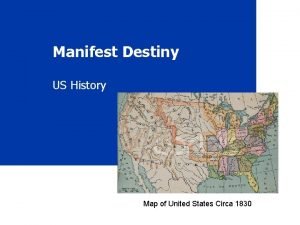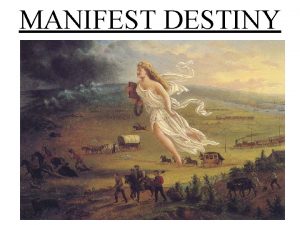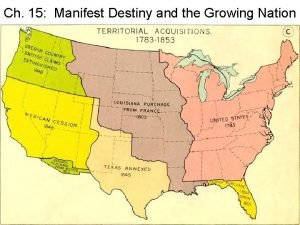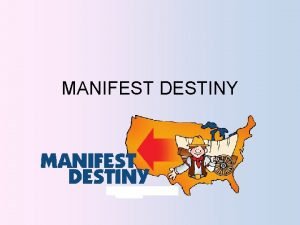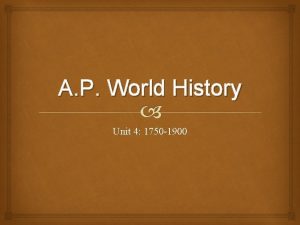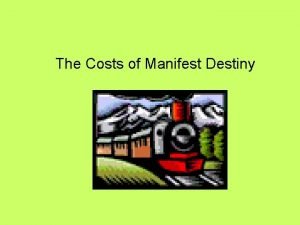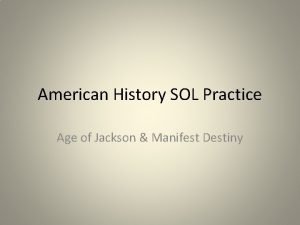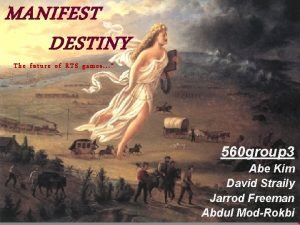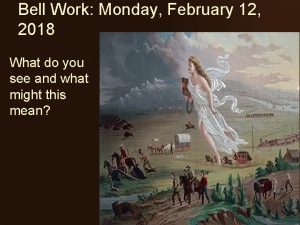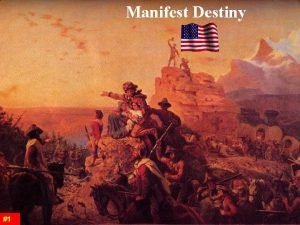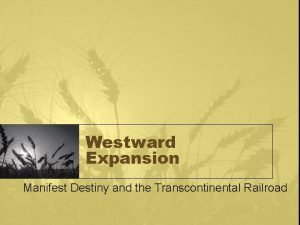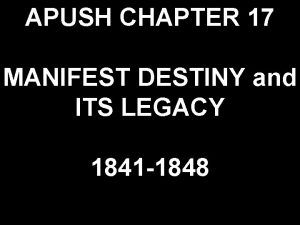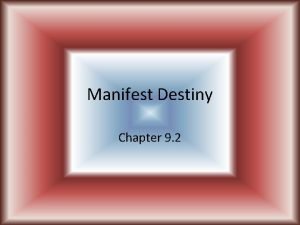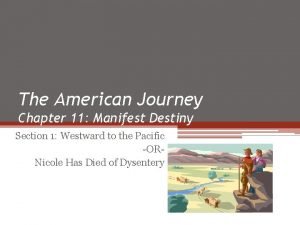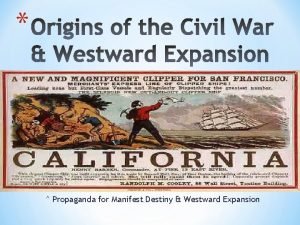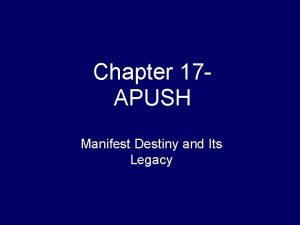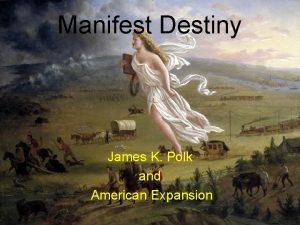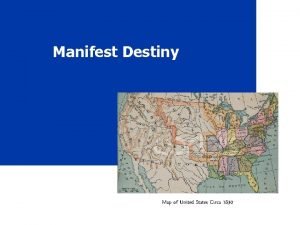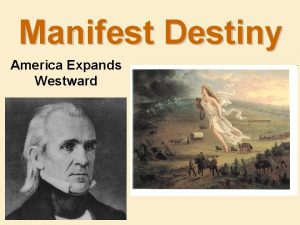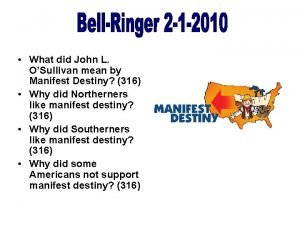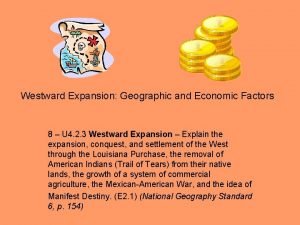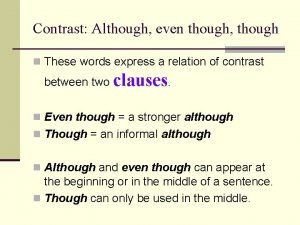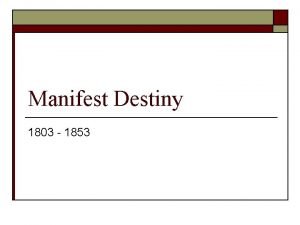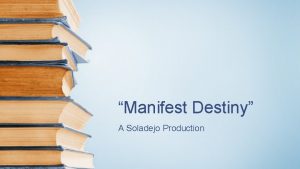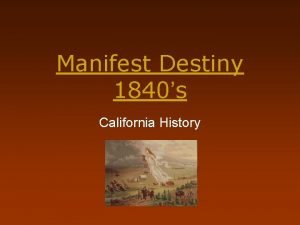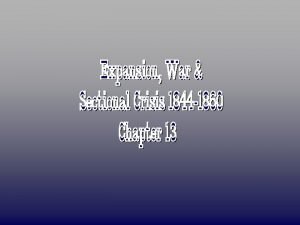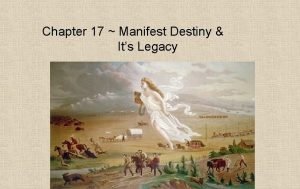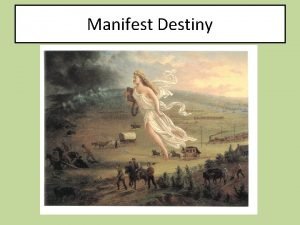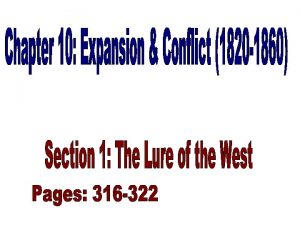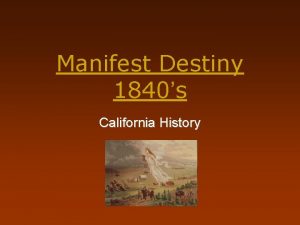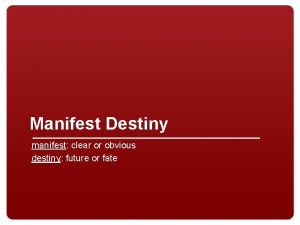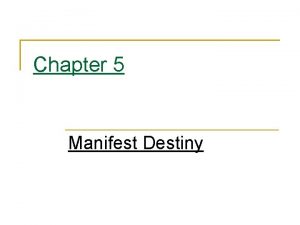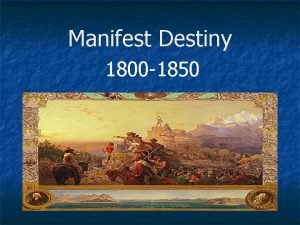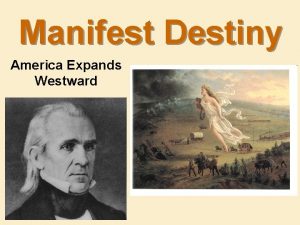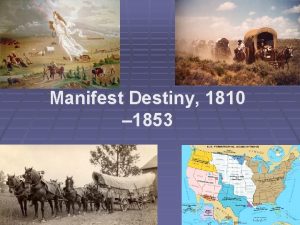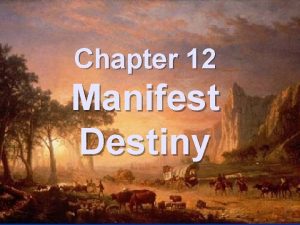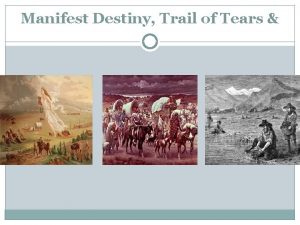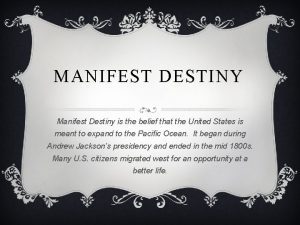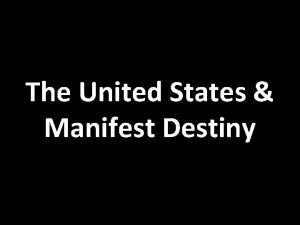Manifest Destiny Even though the land in the


























































- Slides: 58


Manifest Destiny • Even though the land in the West was inhabited by Native Americans, Americans saw it as uninhabited. • Many Americans felt that the United States was destined to stretch from Ocean to Ocean. Manifest destiny: this suggests that expansion was not just good, it was bound to happen even if it meant pushing Native Americans and Mexicans out of the way.

Land Acquisition

Texas Revolution • When Mexico declared its independence from Spain in 1821, the new country included what is now Texas, most of the Southwest, and California. • The Mexican government established liberal land policies to entice settlers. • Americans flooded the region. In return for the land they were supposed to become Mexican citizens.

Republic of Texas • The Americans refused to become citizens of Mexico and ignored the law. • One law that Mexico had in place prohibited slavery. The settlers ignored this law as well. • When Mexico tried to restore order and enforce their laws, the setters rebelled and declared independence.

The Lone Star Republic • In September 1836, Texans raised a flag with a single star. The adopted the above name for their new Republic. • They had their own army and navy. Sam Houston was elected president. • Many Texans wanted to be a part of the U. S. • Northerners feared Texas would be a slave slate if allowed into the Union. • Others feared the annexation of Texas would cause a war with Mexico.

Remember the Alamo

James K. Polk • Elected in 1844, Polk made the idea of Manifest Destiny a government policy. • He wanted to take over the Oregon territory which was disputed with Britain. • During is term an arrangement is made and border between the U. S. and Canada remains the same to this day. • 54, 40 or Fight

War with Mexico • During Polk’s presidency he focused on obtaining the Southwest from Mexico. • He tried to buy the land that failed. • He provoked Mexico until American troops were attacked. • Mexico was already provoked by the annexation of Texas. • Polk used the attack on U. S. troops to argue for a declaration of war.

Wilmot Proviso • The Wilmot Proviso, one of the major events leading to the Civil War, would have banned slavery in any territory to be acquired from Mexico in the Mexican War or in the future, including the area later known as the Mexican Cession.

Western Trails • Oregon Trail: The four to six month journey spanned over half the continent as the wagon trail proceeded about 2, 000 miles west through territories and land that later became six U. S. states

Mormon Trail • One group that travelled west did so for religious reasons. • Many people disapproved of the teachings of a religious group called the Mormons. Polygamy: the practice of being married to more than one wife. Brigham Young, the Mormon leader, moved his people out of the United States and created a settlement near the Great Salt Lake.

Brigham Young • Young had a variety of nicknames, among the most popular being "American Moses, " because, like the Biblical figure, Young led his followers, the Mormon pioneers, in an exodus through a desert, to what they saw as a promised land.

The Gold Rush • In 1839, a Swiss Immigrant named John Sutter convinced the Mexican governor to grant him 50, 000 acres of land in the unsettled Sacramento Valley. • Sutter built a fort and began to build his perfect empire. • In 1848, Sutter sent a carpenter named John Marshall down to the river to build a saw mill.

Gold Discovered • Marshall discovered something shiny while working on the mill. • News of Marshall’s discovery spread quickly. • People rushed to the American River to strike it rich. • Within a year thousands of people started to move West.



How to Reach California 1. Sail 18, 000 miles around South America. 2. Sail to the isthmus of Panama, cross over by land, swamp, and lake. 3. Travel the trails across North America braving weather, Native Americans, and the hardships of the trail. Because the adventure was so tough most of the gold miners were male.

Gold Rush Terms • • 49 ers Boom Town Wild West Ghost Town

Calico

Tombstone

Reform Movements Causes: • New religious ideas that people should help each other. • Awareness of social problems. • Cheap newspapers to publicize more information. Effects: • Abolitionists work to end slavery. • Temperance societies form. • Workers form unions. • Public Education • Women campaign for equal rights.

• Three people who lent powerful voices to the abolition movement were: Sojourner Truth Susan B. Anthony William Lloyd Garrison

Frederick Douglass • Douglass was a runaway slave who sought freedom in the North. • He went to work for William Lloyd Garrison at the Liberator and editor and writer for the paper. • Douglass eventually started his own paper called The North Star. • During the Civil War he recruited blacks into the army.

California Applies for Statehood • The rush for gold brought thousands of people into the territory and made it possible to apply for statehood. • Most California residents wanted the state to be a free state. • The South wanted California to be divided in half and made half free and half slave.

California Enters the Union Free • California grew so quickly that Zachary Taylor allowed them to apply for statehood before going through the territory stage. • This gave Southerners little time to move out west to influence the vote. • In 1850, California was admitted as a free state which gave the Northern states control in the House and the Senate. Zachary Taylor

The Compromise of 1850 • The Compromise of 1850 was an intricate package of five bills. • It was introduced by Senator Henry Clay. • It avoided secession or civil war at the time and quieted sectional conflict for four years until the divisive Kansas-Nebraska Act.

Clay’s Plan 1. To Please the North: California would be admitted as a free state. The slave trade would be banned in Washington D. C. 2. To Please the South: Congress would not pass laws regarding slavery in the other territories and would pass a stronger law regarding runaway slaves. Both sides felt they had to give up too much.

Fugitive Slave Act • The Fugitive Slave Act was passed by the United States Congress on September 18, 1850.

Fugitive Slave Act • This was one of the most controversial acts of the 1850 compromise. It declared that all runaway slaves be brought back to their masters. • Abolitionists nicknamed it the "Bloodhound Law" for the dogs that were used to track down runaway slaves. • People who hid slaves could be arrested or fined.

Harriet Beecher Stowe So this is the lady who started the Civil War. -- Abraham Lincoln

Uncle Tom’s Cabin • Uncle Tom's Cabin is an antislavery novel by American author Harriet Beecher Stowe. • Published in 1852, Uncle Tom's Cabin first appeared as a 40 -week serial in National Era, an abolitionist periodical. Because of it’s popularity it was later transformed into a book. • The novel had a profound effect on attitudes toward African Americans and slavery in the United States.

Uncle Tom’s Cabin 1852 § Sold 300, 000 copies in the first year. § 2 million in a decade!

1852 Presidential Election Franklin Pierce was the 14 th President. Democrat His inoffensive personality caused him to make many friends, but he suffered tragedy in his personal life and as president subsequently made decisions which were widely criticized and divisive in their effects, thus giving him the reputation as one of the worst presidents in U. S. history √ Franklin Pierce

Kansas-Nebraska Act • The issue of slavery brought bloodshed to the West in 1854 when Stephen A. Douglas of Illinois drafted a bill to reorganize the territorial governments in the Nebraska Territory. • Douglas proposed that the territory be divided into two territories: Kansas and Nebraska • The issue of slavery would be handled by popular sovereignty. Stephen Douglas

Kansas-Nebraska Act, 1854 ØThe new law would get rid of the Missouri Compromise. Why? ? ? ØSoutherners supported the idea of getting rid of the Missouri Compromise. ØFew people realized that passing this law would turn Kansas into a battlefield over slavery.

Bleeding Kansas • Pro-slavery and anti-slavery settlers rushed to the Kansas territory to vote. • At the time of the election there were more pro-slavery settlers because 5, 000 Missiourians crossed over and voted illegally. • Anti-slavery protestors boycotted the official government and formed a government of their own. • Settlers on both sides armed themselves.

• John Brown was an abolitionist who was born in Connecticut but raised in Ohio. • The Akron home of John Brown stands at Copley and Diagonal Roads in West Akron.

John Brown and Akron • John Brown moved to Akron in 1844 and worked with Simon Perkins Jr. The Perkins mansion still stands across from the Brown home. • Simon Perkins Jr. was the son of Simon Perkins, founder of Akron.

John Brown • John Brown was an extreme abolitionist who showed up after a mob of pro-slavery settlers attacked the town of Lawrence, Kansas. • Brown set out to avenge the attack. He and seven others murdered five people involved in the attack. • A civil war broke out in Kansas that lasted for three years.

“Bleeding Kansas”

Violence in Congress Preston Brooks Charles Sumner • While violence was being spread in Kansas, blood was being spilled in the nation’s capital. • Senator Charles Sumner gave a speech attacking pro-slavery forces in Kansas. • A. P. Butler of NC told a relative about the speech and the relative, Preston Brooks, attacked Sumner at his desk in his office.

Founding of the Republican Party • The Republican Party was first organized in 1854, growing out of the opposition to Stephen Douglas's January introduction of the Kansas. Nebraska Act. • Differences on the issue of slavery caused the Whig Party to split. • Southern Whigs were destroyed by the split. • Northern Whigs became the Republican Party.

American Party Know Nothings • The Know Nothing movement was a nativist American political movement of the 1840 s and 1850 s. • It was empowered by popular fears that the country was being overwhelmed by Irish Catholic immigrants. Nativism: opposed to immigration or recent immigrants into the country.

1856 Presidential Election √ James Buchanan Democrat John C. Frémont Republican Millard Fillmore Know-Nothings In the North the race was between Buchanan and Fremont, in the South the race was between Buchanan and Fillmore. Buchanan wins the majority because the opposing voters were split.

Dred Scott v. Sanford, 1857 The split in the country was made worse after the Supreme Court ruled in the Dred Scott case. When Scott’s owner died, he sued for his freedom. The courts ruled against Scott. The opinion of the court was that Scott was not a U. S. citizen and could not use the legal system.

The Lincoln-Douglas Debates, 1858 The Lincoln–Douglas Debates of 1858 were a series of seven debates between Abraham Lincoln, the Republican candidate, and the incumbent Stephen A. Douglas, a Democrat, for an Illinois seat in the United States Senate. The main discussion in all the debates was slavery. Topics discussed: -Missouri Compromise -Bleeding Kansas -Dred Scott -Fugitive Slave Law

The House Divided Speech "A house divided against itself cannot stand. " I believe this government cannot endure, permanently, half slave and half free. I do not expect the Union to be dissolved — I do not expect the house to fall — but I do expect it will cease to be divided.

John Brown at Harper’s Ferry In 1859, John Brown planned to inspire slaves to fight for their freedom. To do this he needed to capture the arsenal at Harper’s Ferry, Virginia. Brown and 18 followers captured the arsenal and killed four people in the raid.

The Fate of John Brown • Brown and six others were captured after battling with U. S. Marines. They were executed. • Southerners were outraged at Brown’s actions. • Northerners considered him a hero and bells and guns were used to salute him after he was executed.

√ Abraham Lincoln Republican 1860 Presidential Election Stephen A. Douglas Northern Democrat John Bell Constitutional Union John C. Breckinridge Southern Democrat

The Election Becomes Two Races The North Abraham Lincoln Stephen Douglas The South John Breckinridge John Bell Lincoln and Breckinridge had the most extreme views. Douglas and Bell were considered moderate with their views. Lincoln won because the population in the North was greater.

1860 Election: A Nation Coming Apart

1860 Election Results

Southern States Secede • Before the election many Southerners warned that they would secede from the Union. • The Southern state’s argued that they had voluntarily joined the Union and they could voluntarily leave. • On December 20, 1860, South Carolina became the first state to secede. • In the upcoming weeks, Mississippi, Florida, Alabama, Georgia, Louisiana, and Texas joined the secession. • Early 1861 the states that seceded met to discuss forming a confederate government.

Crittenden Plan: A Last Ditch Appeal to Sanity John J. Crittenden proposed a compromise plan involving six constitutional amendments and four resolutions. The heart of the compromise was an amendment prohibiting slavery in all territory of the United States "now held, or hereafter acquired, " north of latitude 36 degrees 30 minutes. Senator John J. Crittenden (Know-Nothing-KY)

South Carolina Secedes! Dec. 20, 1860

Fort Sumter: April 12, 1861
 Contrast and concession connectors
Contrast and concession connectors Manifest destiny newspaper
Manifest destiny newspaper Manifest destiny book
Manifest destiny book Manifest destiny
Manifest destiny Whats the definition of manifest destiny
Whats the definition of manifest destiny Manifest destiny map
Manifest destiny map Manifest destiny and the growing nation
Manifest destiny and the growing nation American progress by john gast 1872
American progress by john gast 1872 Manifest destiny
Manifest destiny Growth of the united states to 1853
Growth of the united states to 1853 Chapter 17 manifest destiny and its legacy
Chapter 17 manifest destiny and its legacy Chapter 12 manifest destiny
Chapter 12 manifest destiny Essential questions for westward expansion
Essential questions for westward expansion Reason for manifest destiny
Reason for manifest destiny America is destined for better deeds
America is destined for better deeds Manifest destiny
Manifest destiny Indian removal act map activity
Indian removal act map activity Manifest destiny map with dates
Manifest destiny map with dates Manifest destiny
Manifest destiny Travel in a growing nation answer key
Travel in a growing nation answer key Manifest destiny
Manifest destiny Define manifest destiny *
Define manifest destiny * Manifest destiny era
Manifest destiny era Jimmy fallon gadsden purchase
Jimmy fallon gadsden purchase Costs of manifest destiny
Costs of manifest destiny Manifest destiny poems
Manifest destiny poems Manifest destiny who is the lady
Manifest destiny who is the lady Manifest destiny was used to justify an american desire to
Manifest destiny was used to justify an american desire to Manifest rts
Manifest rts How does this painting represent manifest destiny?
How does this painting represent manifest destiny? American progress book
American progress book Transcontinental railroad manifest destiny
Transcontinental railroad manifest destiny Apush chapter 17
Apush chapter 17 Manifest destiny 1840s
Manifest destiny 1840s Whats manifest destiny
Whats manifest destiny Manifest destiny clipart
Manifest destiny clipart Manifest destiny effect
Manifest destiny effect Westward expansion propaganda
Westward expansion propaganda His accidency apush
His accidency apush Which president completed manifest destiny
Which president completed manifest destiny Manifest destiny map
Manifest destiny map Define manifest destiny in your own words
Define manifest destiny in your own words Monroe doctrine and manifest destiny
Monroe doctrine and manifest destiny John l osullivan
John l osullivan Reasons for manifest destiny
Reasons for manifest destiny Difference although even though
Difference although even though Although we walk in the flesh
Although we walk in the flesh Even though beowulf was originally dgp
Even though beowulf was originally dgp Even though i walk
Even though i walk Even though the banana seemed to change color
Even though the banana seemed to change color Though i walk
Though i walk Language
Language Regular expression of even even language
Regular expression of even even language An area of land largely enclosed by higher land
An area of land largely enclosed by higher land Identify the landform
Identify the landform Though we are hard pressed
Though we are hard pressed Though l
Though l Shahjahan poem by rabindranath tagore in bengali
Shahjahan poem by rabindranath tagore in bengali Spicy riddles fill in the blanks
Spicy riddles fill in the blanks
